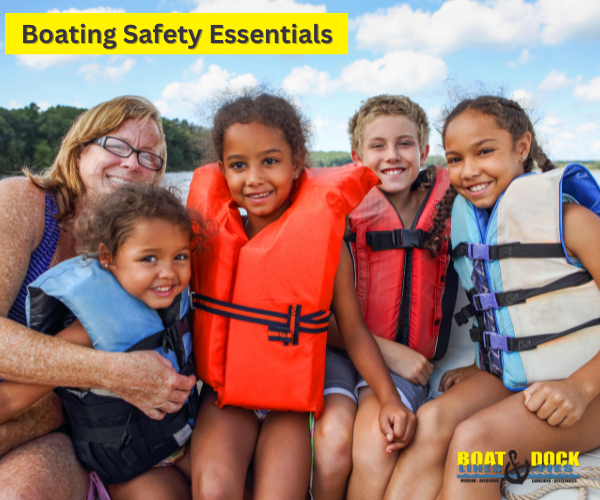Is your boat prepared for a day on the water? Being a boat owner comes with incredible responsibility. Don't worry, we've got your back! Every boat outing is different, some are fishing adventures while others are tubing family fun... no matter what your day looks like, it is best to be prepared with all safety essential items before departure. Take a look at the list we have created, which should make you feel comfortable and responsible when taking family and friends out on your watercraft.
Safety Equipment Needed for Your Boat
Life Jacket (PDFs) A U.S. Coast Guard-approved PFD (personal flotation device) is mandatory and must be available for each person on board. All children 12 years old and under are required to wear a life jacket at all times aboard a moving water vessel. When pulling a skier, wake surfer, or tuber behind your boat, he or she must be wearing a PDF as well. In case of an emergency, you should instruct ALL passengers to put on their life jackets. (Prior to departure, make sure you have enough life jackets for each guest.
Throwable Floatation Devices You will also need at least one floating device that you can toss to an individual in the water in the event their is an emergency. This flotation device is in additional to the personal PDF all guests must have onboard. A throwable personal flotation device means a U.S. Coast Guard approved Type IV device for use on any watercraft such as, but not limited to, a buoyant cushion, ring buoy, or horseshoe buoy.
One Anchor Onboard Make sure to have one anchor, attached to a an anchor line, onboard your vessel. It is a good idea to also have two fenders and a couple of fender lines for docking onboard too. You want to set yourself up for success on all outings as well as be prepared for difficult situations that may present themselves.
Kill Switch Tether (for boats & sea-doos) Kill switches have been installed in the majority of recreational vessels over the last decade, but there has not been a law enforcing the use of this safety feature until April of 2021. The kill switch consists of a cord or lanyard that is attached to the captain or driver around their wrist or body. The other end is attached to a button/switch on the boat with a special clip. Wearing a lanyard or cord not only ensures that your boat stays close if you fall overboard, but it also prevents you from being run over by your own boat.
It would be very beneficial to review the New Kill Switch Law that came into effect in April of 2021.

Visional Indicator for Signaling or Distress Signals In other words a FLAG and FLARES! As a young child I loved holding the flag. I may not have been behind the boat skiing or tubing, but I was still apart of the ride since I was holding the flag. I felt a sense of responsibility. The tuber or skier was counting on me to raise my flag once they fell, making sure the driver knew to slow down, flip the boat around, and check if they are okay. For boats under 16' in length: Distress signals are only required when operating between sunset and sunrise. If operating at night, one electric distress light or three combination day/night red flares are required.
Noise Indicator for Signaling You will need at least two sound-signaling devices on board, such as an air horn, bell, or whistle. If you are carrying an air horn, also pack a spare can of compressed air. Having a this type of device onboard can be very useful, especially at night and if you run into fog.
Fire Extinguisher You will need at least one B-1 type extinguisher and boats 26 to just under 40 feet need two B-1 types or one B-2 type. They also need to be stored in an accessible place on your water vessel. Check that it's securely mounted and not expired. Let all passengers know once onboard the boat where the fire extinguisher is location.
Medical Kit Keeping a first aid kit onboard will make your boating experience much easier. Injuries on the water come in many forms and degrees of severity – a scratch from fishing to broken bones. Since medical attention is seldom close by, make sure you have a marine First Aid Kit that is well-stocked and up-to-date. You can either put together your own First Aid Kit or purchase one online. Check out Hodges Marine's First Aid Kits for reference or to purchase.
Please also check out this article which lists the minimum U.S. Coast Guard Requirements and includes their suggestions for additional items to keep you safe on the water. In addition, here is a Must-Have List of items you should have on your boat in Oregon.
For more on safety, be sure to read our Top Tips for Safe and Responsible Boating that outlines the basics to ensure you're safe and responsible while out on the water. You may also want to check out our Which Vessel Must Give Way? Crucial Rules of Boating which explains boating guidelines and "right of way" regulations.
(Remember to inspect your boat lines and dock ties and replace as needed. Boat lines and dock ties weather and weaken over time.)
(Boat Lines & Dock Ties is a participant in the Amazon Services LLC Associates Program, an affiliate advertising program designed to provide a means for sites to earn advertising fees by advertising and linking to Amazon.com. Amazon and the Amazon logo are trademarks of Amazon.com, Inc. or its affiliates. As an Amazon Associate we earn affiliate commissions from qualifying purchases.
All third-party marks listed above are the sole property of their respective owner. No affiliation or endorsement is intended or implied.)

